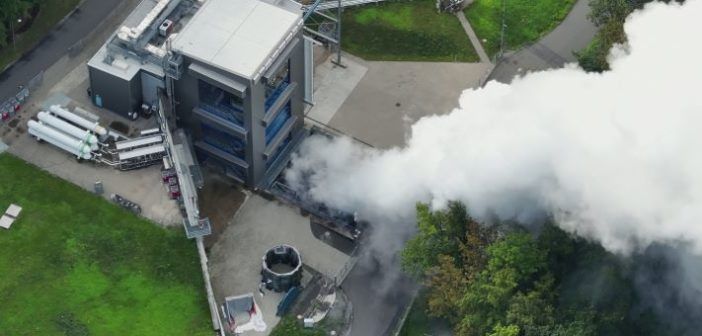Last week the European Space Agency’s Ariane 6 launch vehicle fired its two upper-stage engines to simulate the way they will have to operate together at German aerospace agency DLR’s engine test centre in Lampoldshausen, Germany.
The test, which took place on September 1, fired the new Vinci engine and a smaller Auxiliary Power Unit (APU). The hot fire test was conducted on Lampoldshausen’s P5.2 test stand.
“This test is a central milestone and elementary for the qualification of the upper school for their first start,” said Walther Pelzer, DLR board member and head of the German Space Agency at DLR.
“DLR is known worldwide for its test infrastructure and is setting new standards in Europe with the P5.2 test stand.”
Vinci, the upper stage engine of Ariane 6 is fed by liquid hydrogen and oxygen and can be stopped and restarted multiple times. This will enable it to place satellites into different orbits and then de-orbit the upper stage, so it is not left behind as hazardous debris in space.
The APU makes it possible for Vinci to restart in space, by maintaining adequate pressure in the fuel tanks and preventing bubbles in the fuel lines. The power unit uses small amounts of liquid hydrogen and oxygen from the main tanks – replacing a system which relied on large quantities of tanked helium.

Ariane 6 is a new design created to succeed Ariane 5 as Europe’s heavy-lift launch system. The rocket is slated to make its first flight next year, after problems prevented testing of the rocket’s core stage taking place earlier this year in French Guiana.
The upper and core stage of Ariane 6 was fuelled up and its core stage engine fired on September 5 at the European Spaceport in Kourou, French Guiana for a hot fire test.
With the rocket standing on its launch pad, the Vulcain 2.1 engine was ignited, fired for four seconds as planned and switched off before its liquid oxygen and liquid hydrogen fuels were drained to their separate underground tanks.
According to a tweet from the European Space Agency a short hot firing test of Ariane 6’s upper and core stage was postponed earlier in the year because of a technical issue affecting the control bench governing the critical fluidic operations – the launcher’s filling and automated countdown.
ESA owns and manages the Ariane 6 program and defines its performance objectives, while the ArianeGroup is the prime contractor, and the launch operator is Arianespace.
France’s space agency, CNES, operates Europe’s Spaceport in French Guiana – the home of Ariane launchers since the first liftoff in 1979.




